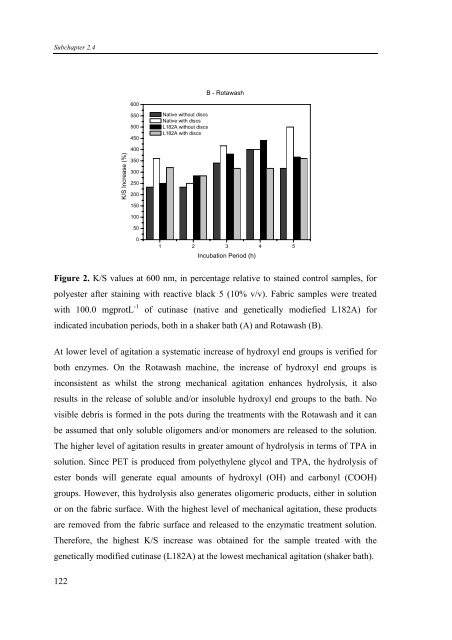Surface Modification of Cellulose Acetate with Cutinase and ...
Surface Modification of Cellulose Acetate with Cutinase and ...
Surface Modification of Cellulose Acetate with Cutinase and ...
You also want an ePaper? Increase the reach of your titles
YUMPU automatically turns print PDFs into web optimized ePapers that Google loves.
Subchapter 2.4<br />
122<br />
K/S Increase (%)<br />
600<br />
550<br />
500<br />
450<br />
400<br />
350<br />
300<br />
250<br />
200<br />
150<br />
100<br />
50<br />
0<br />
Native <strong>with</strong>out discs<br />
Native <strong>with</strong> discs<br />
L182A <strong>with</strong>out discs<br />
L182A <strong>with</strong> discs<br />
B - Rotawash<br />
1 2 3 4 5<br />
Incubation Period (h)<br />
Figure 2. K/S values at 600 nm, in percentage relative to stained control samples, for<br />
polyester after staining <strong>with</strong> reactive black 5 (10% v/v). Fabric samples were treated<br />
<strong>with</strong> 100.0 mgprotL -1 <strong>of</strong> cutinase (native <strong>and</strong> genetically modiefied L182A) for<br />
indicated incubation periods, both in a shaker bath (A) <strong>and</strong> Rotawash (B).<br />
At lower level <strong>of</strong> agitation a systematic increase <strong>of</strong> hydroxyl end groups is verified for<br />
both enzymes. On the Rotawash machine, the increase <strong>of</strong> hydroxyl end groups is<br />
inconsistent as whilst the strong mechanical agitation enhances hydrolysis, it also<br />
results in the release <strong>of</strong> soluble <strong>and</strong>/or insoluble hydroxyl end groups to the bath. No<br />
visible debris is formed in the pots during the treatments <strong>with</strong> the Rotawash <strong>and</strong> it can<br />
be assumed that only soluble oligomers <strong>and</strong>/or monomers are released to the solution.<br />
The higher level <strong>of</strong> agitation results in greater amount <strong>of</strong> hydrolysis in terms <strong>of</strong> TPA in<br />
solution. Since PET is produced from polyethylene glycol <strong>and</strong> TPA, the hydrolysis <strong>of</strong><br />
ester bonds will generate equal amounts <strong>of</strong> hydroxyl (OH) <strong>and</strong> carbonyl (COOH)<br />
groups. However, this hydrolysis also generates oligomeric products, either in solution<br />
or on the fabric surface. With the highest level <strong>of</strong> mechanical agitation, these products<br />
are removed from the fabric surface <strong>and</strong> released to the enzymatic treatment solution.<br />
Therefore, the highest K/S increase was obtained for the sample treated <strong>with</strong> the<br />
genetically modified cutinase (L182A) at the lowest mechanical agitation (shaker bath).

















